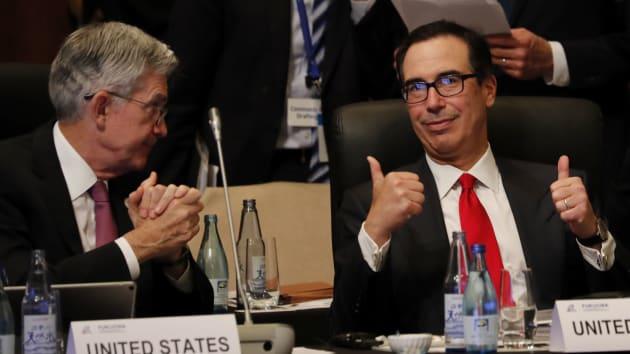Shanghai Accord 2.0? Powell, Mnuchin To Lead Tuesday’s Emergency G-7 Coronavirus Call
While traders were disappointed by the lack of an emergency, intermeeting rate cut by the Fed on Sunday which sent futures sharply lower in early Monday trading, speculation that such an announcement was merely delayed to Tuesday morning, when as Bloomberg reported an emergency G-7 conference call would take place, quickly reversed the market’s dour mood and sparked a record 1,294 point gain in the Dow Jones.
And while we still don’t know what is on the agenda, and whether officials will announce some monetary stimulus, or fiscal boost, or some combination of the two, we do know thanks to CNBC’s Steve Liesman that the 7am ET teleconference call between gGlobal financial ministers and central bankers will be led by Treasury Secretary Steven Mnuchin and Fed Chair Jerome Powell and that – as one would expect – representatives of the Group of Seven industrialized nations will attend the call. And as a CNBC source notes, following the “coordinating call” for the financial and economic response to the virus, a communique is scheduled for after the call, which likely means that the call participants will be loathe to disappoint a market – and a Goldman Sachs – which as recently as this morning was expecting no less than two rate cuts at or before the March 18 FOMC meeting.
So is the reason for today’s historic market ramp because – with both Powell and Mnuchin there – traders now expect tomorrow’s announcement to be nothing short of the second coming of the notorious Shanghai Accord from Feb 2016 which unleashed a nearly two-year long buying spree in the aftermath of China’s mini recession?
Perhaps… but as Bloomberg’s Ye Xie writes, it may not be so easy to replicate the tremendous market outperformance that was unlocked by the first Shanghai Accord just over four years ago.
He explains below:
Are Markets Looking for a ‘Shanghai Accord’ 2.0?
Bad news is good news. That cliché seems to be the best explanation for Monday’s trading. Or is it? The worst-ever China PMI data? No problem. The Shanghai Composite surged 3.6%. More casualties in the U.S. from the coronavirus? Well, the S&P 500 jumped 4.6%.
What excites the markets is a call among G-7 finance ministers and central bankers Tuesday to discuss how to respond to the coronavirus. Maybe some sort of coordinated policy stimulus? China is not part of the G-7, but expectations for more stimulus from Beijing have been high ever since the outbreak.
Remember the so-called “Shanghai Accord” at the G-20 in Shanghai in February 2016? It is most likely a coincidence, but the meeting turned out to be the turning point for global markets as the Fed shortly thereafter postponed tightening, which helped curb the dollar rally.
Are we about to dust off the old playbook?
At first glance, the price action certainly fits the narrative. Treasury yield curves steepened with 2s10s rising to 26 basis points. Central bank rate cuts and fiscal spending globally should push the short-end lower more than the longer-end. Check. In China, telecommunication, industrial and material shares led the rally Monday. It’s a classic reaction to old-style infrastructure stimulus. Check.
Here’s the rub in the theory that the global plunge protection team can save the world, though: The hope for a bottoming in global growth expectations hasn’t been corroborated by other assets. For example, cyclical stocks in the U.S. are still underperforming defensives. Secondly, some of the assets sensitive to China’s stimulus aren’t moving much. The base-metals market hasn’t shown any sparkle lately.
The Australian dollar, a proxy for China sentiment, is hovering at the lowest since 2009. Either they are mispriced or that the spillover from China stimulus won’t be as large as before. For global markets to stabilize, policy makers need to react.
More importantly, we need some signs that the virus is under control globally. We are probably getting closer to the first condition, but still some way away from the second one.
Tyler Durden
Mon, 03/02/2020 – 18:12
